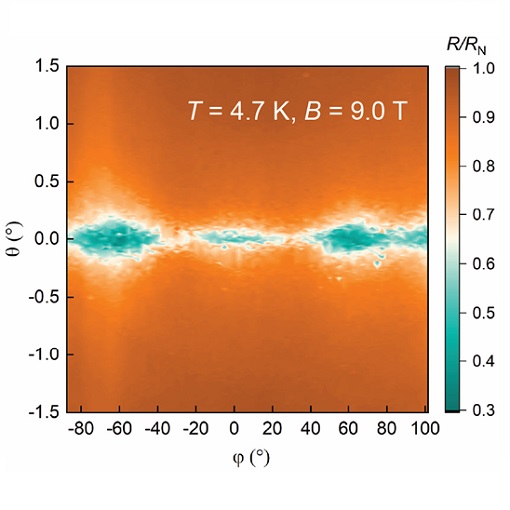
Hunt for the anisotropy in the orbital Fulde–Ferrell–Larkin–Ovchinnikov state
The conventional Fulde-Ferrell-Larkin-Ovchinnikov (FFLO) state characterized by Cooper pairings with finite momentum, is formed by the Zeeman effect of an external magnetic field that breaks the time-reversal symmetry. When the Zeeman effect is suppressed due to the spin-locking in the presence of Ising-type spin-orbit coupling (SOC), the conventional FFLO scenarios are no longer effective. Instead, an unconventional FFLO state is formed by coupling the orbital effect of magnetic fields with SOC, providing an alternative mechanism in superconductors with broken inversion symmetries. The group of J. Ye (University of Groningen, Netherlands) has shown the evidence of such an orbital FFLO state in multilayer Ising superconductor 2H-NbSe2. A characteristic rotational symmetry transition from two- to six-fold is observed across the phase boundary. This study highlights an alternative route to finite-momentum superconductivity and provides a universal mechanism to prepare orbital FFLO states in similar materials with broken inversion symmetries. To resolve the extremely weak anisotropy in the orbital FFLO state, the team developed a method to subtract the effect of canting angle using atto3DR.
This measurement was realized with the atto3DR.
Further reading:
P. Wan et al., Nature 619, 46 (2023)
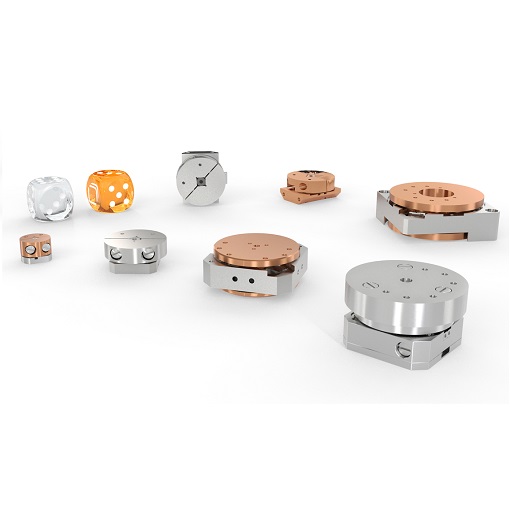
Adding twists and turns to Magneto-Transport Measurements
A constantly increasing number of scientific experiments and their foreseeable applications require the characterization of materials in terms of three-dimensional magneto-transport properties. In order to explore the cutting-edge limits of those features, one requires not only a wide sample temperature range, from room temperature to down to few mK, but also a powerful vector magnetic field. However, typical vector magnets are limited to in field strength: at least two directions over three cannot exceed one or two Tesla.
The renowned attocube expertise with nanopositioners has created an elegant solution to overcome this limit, by equipping the transport insert with a broad portfolio of sample rotators, which are able to perform also in ultra-high vacuum and variable/low temperature conditions. The offer is not simply limited to single rotators: attocube provides also a eucentric double sample rotator - the atto3DR - and, moreover, we also provide a complete measurement system - the attoTMS. The system includes the atto3DR, the automated attoDRY2100 cryostat and an all-in-one acquisition electronics Nanonis Tramea, with one dedicated software to rule them all.
Find out more about the benefits of rotating your sample with the help of attocube products.
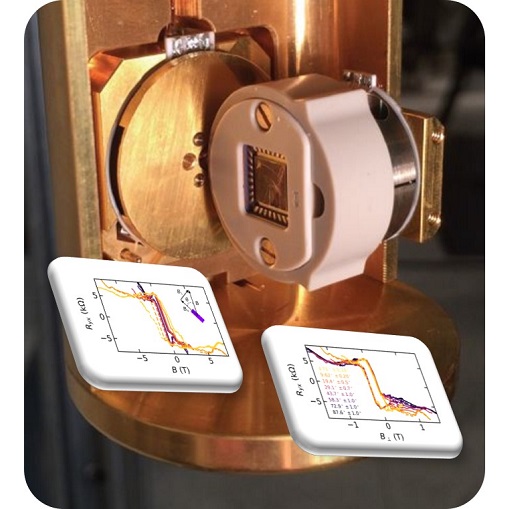
Orbital ferromagnetism in twisted bilayer graphene below 30 mK
Van der Waals heterostructures, particularly in the form of magic-angle twisted bilayer graphene (tBLG), are one of the hottest topics in today's solid state physics research. Previous measurements on tBLG already indicated ferromagnetism and Chern insulating behavior as deduced from a large hysteretic anomalous Hall effect which was subsequently confirmed to be quantized. A. L. Sharpe and co-workers now experimentally showed via transport measurements that the ferromagnetism in tBLG is highly anisotropic, strong evidence for an orbital rather than spin origin of ferromagnetism, something never before observed at low magnetic field.
For their measurements, the group mounted a sample of tBLG encapsulated in boron nitride flakes onto attocube's atto3DR double rotator, working at electron temperatures down to less than 30 mK facilitated by careful filtering, and in magnetic fields of up to 14 T. A dedicated in-situ calibration of the tilt angle using the Hall resistance allowed for accurate control of the exact in-plane and out-of-plane orientations during their experiments.
This measurement was realized with the atto3DR.
Further reading:
A. L. Sharpe et al., Nano Lett. 2021, 21, 10, 4299–4304
Angle Dependent Magnetoresistance Measurement at Cryogenics
Due to the arbitrary orientation inherent to self-assembled materials on the substrate, typical characterization techniques such as magnetoresistance measurements conducted at cryogenic temperatures greatly benefit from the possibility to freely change the mutual orientation of external magnetic field and sample. Although this is easily possible e.g. by using a 3D vector magnet setup, the associated costs (>> 100 k$) are often prohibitive. Single axis sample rotator setups on the other hand not only require choosing either an out-of-plane or in-plane configuration prior to cooldown, but also put firm restrictions on certain measurements which rely on a precise orientation of the field e.g. perpendicular or parallel to an initially unknown direction along a sample structure. The perfect solution to such applications is attocube’s 3-dimensional rotator atto3DR.
Similar to a recent publication by C. H. Butschkow and co-workers from the group of Prof. Dieter Weiss (Univ. of Regensburg), magnetotransport measurements on individual GaAs/(Ga,Mn)As core-shell nanowires (top figure) have been conducted.
The center figure shows magnetoresistance at 5 T as a function of the angle between externally applied magnetic field and the nanowire axis for different rotation planes: (orange) in-plane rotation, referring to the SiO2 substrate plane, (green) out of plane (perpendicular) rotation with the long nanowire axis (typically 4 µm long and 100 nm in diameter) entirely in the rotation plane, and (blue) out of plane (transversal) rotation with the rotation plane transversal to the nanowire axis.
The bottom figure shows the normalized magnetoresistance as a function of the angle between externally applied magnetic field and the nanowire axis for various magnitudes of the external magnetic field.
(measured by C. Butschkow in collaboration with attocube application labs 2012; sample courtesy of C. Butschkow, University of Regensburg).
This measurement was realized with the atto3DR.
Further reading:
C. Butschkow et al., Phys. Rev. B 87, 245303 (2013)
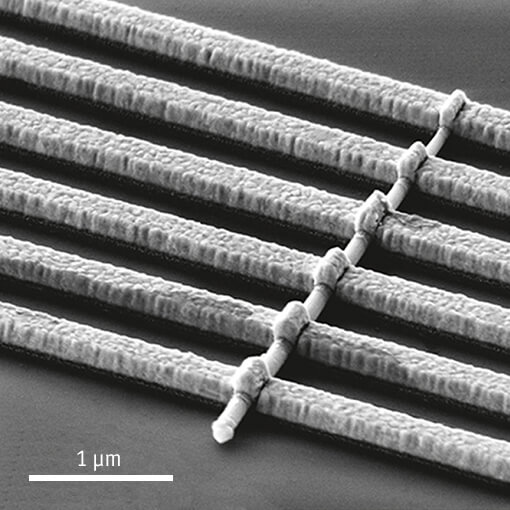

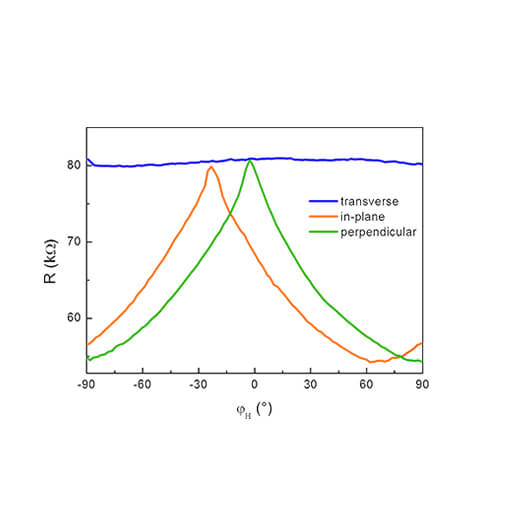
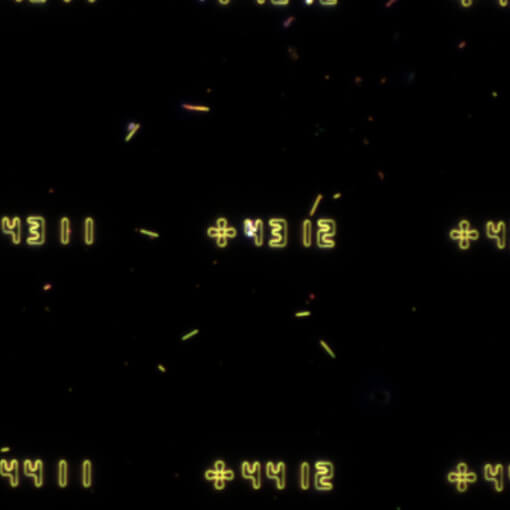
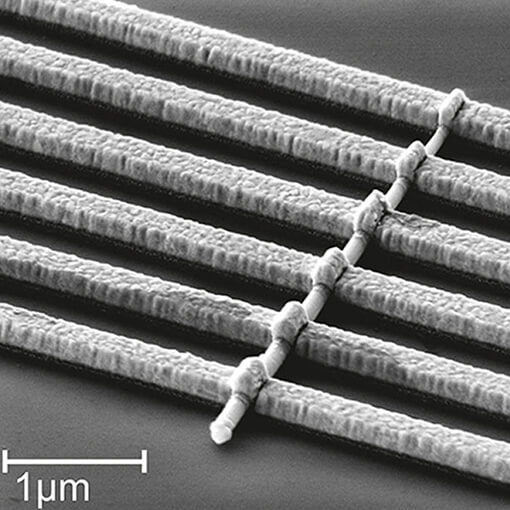
Magnetoresistance of self-assembled GaMnAs based nanowires
The relatively new class of self-assembled ferromagnetic nanowires could potentially be used for producing e.g. one-dimensional spin valve transistors or ferromagnetic single electron transistors, while maintaining a high flexibility in the choice of material as well as the axial and radial degrees of freedom. Due to the arbitrary orientation inherent to self-assembled materials on the substrate, typical characterization techniques such as magnetoresistance measurements conducted at cryogenic temperatures greatly benefit from the possibility to freely change the mutual orientation of external magnetic field and sample. To avoide an expensive 3D vector magnet the atto3DR, a 3-dimensional rotator offers a good a reliable solution for transport measurements which is in particular interesting in the field of mesoscopic physics at cryogenics.
This measurement was realized with the atto3DR.
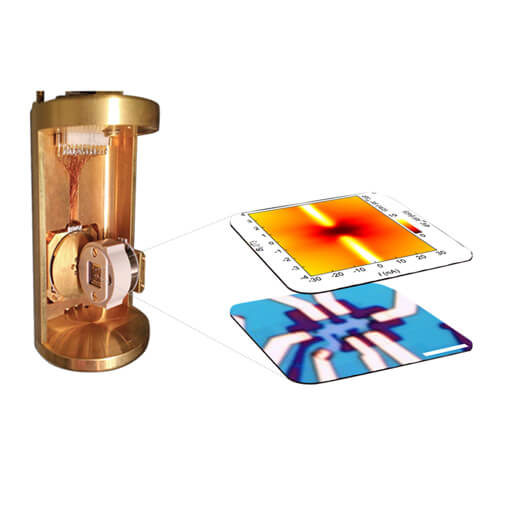
Van der Waals heterostructure under rotation at 40 mK
Understanding the mechanism of high temperature (high Tc) superconductivity is a central problem in condensed matter physics. Van der Waals heterostructures provide novel materials as model systems for quantum phenomena. An international collaboration (Berkeley, Stanford, Shanghai, Tsukuba, Seoul) reports in Nature signatures of tunable superconductivity in these special heterostructures, detected via a sharp drop in the resistivity and a plateau in the I-V curve below 1 K.
The transport measurements are performed in a dilution cryostat with a base temperature of 40 mK achieved through careful filtering. For in-plane measurements, the atto3DR double sample rotator was used, which conveniently allows for using the full field of a single solenoid in an arbitrary orientation. The authors find transitions from the candidate superconductor to Mott insulator and metallic phases, proving that the TLG/hBN superlattice provides a unique model system to study the triangular Hubbard model and its relation to unconventional superconductivity as well as potentially novel electronic states.
This measurement was realized with the atto3DR.
Further reading:
Guorui Chen, et al.; Nature, 572, 215–219 (2019)

